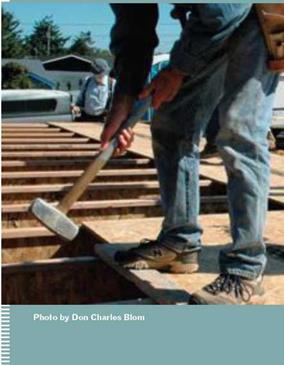SQUARE
Floors may seem to be the simplest of the challenges facing a new builder, but the importance of establishing a firm, sound, dependable connection between a house, the foundation, and the earth cannot be overstated. Everything rests, quite literally, on the quality of the foundation and framing work done in the first few days or so after the concrete contractor has left. Our first house, in coastal Oregon, had a concrete foundation made from beach sand. Sixty years of wind and rain had washed much of that sand back toward the beach, leaving us with a shaky, tilted floor that wasn’t even bolted to the foundation.
Know the Foundation Fundamentals
Take a deep breath. Having found and purchased a lot, bought or drawn up the plans, obtained the permits, cleared the land, run power to the site, and completed the necessary grading, drainage, and excavation work, you’re finally ready to begin working on the foundation. You’ve already come a long way.
Whenever I think about foundations, I can’t help but recall being told as a child, “You’re on your feet most of the day, so wear good shoes.” A foundation is like a pair of shoes—quality makes all the difference. Walk around all day in poor shoes and your whole body feels lousy. Build a house on a poor foundation and the entire house is unstable.
![]()
 All foundations need proper drainage. In addition to installing drainpipe around the footings, make sure that the finished grade slopes away from the house. If gutters and downspouts are installed, use elbows and splash plates to direct runoff away from foundation walls.
All foundations need proper drainage. In addition to installing drainpipe around the footings, make sure that the finished grade slopes away from the house. If gutters and downspouts are installed, use elbows and splash plates to direct runoff away from foundation walls.

foundation are shown in the illustration above. However, if you’re planning to build a house, it’s a good idea to consider all your foundation options. Talk to builders and foundation subcontractors in your area to find out which foundations and special site conditions to consider.
If you’re building a crawl-space foundation, as we did here, find out about the ventilation requirements. In most areas, vents are required in crawl-space foundations. In some areas, codes have been updated to allow for an unvented crawl space (see the sidebar on the facing page).
Local soil conditions have a lot to do with choosing and constructing a foundation. Extra care must be taken when building on clay-rich soils, which exist in many parts of the country. Clay expands when saturated with moisture.
This can exert tremendous pressure on a foundation. I have seen how this expansive action moves footings, cracks slabs, and causes extensive damage to a house. When builders are aware of the potential problems with clay soil, they can take precautions to avoid damaging effects (see the drainage guidelines discussed in the sidebar on p. 52). I have worked on sites where several feet of clay soil were removed and replaced with nonexpansive soil, which was then compacted before the footings were poured.
Foam forms are worth considering
If you haven’t done so already, take a look at the possibilities offered by insulated concrete forms (ICFs). These lightweight foam forms are easy to handle and assemble, and they stay in place to provide wall insulation after the foundation wall is poured (see the sidebar on p. 54). With








Leave a reply